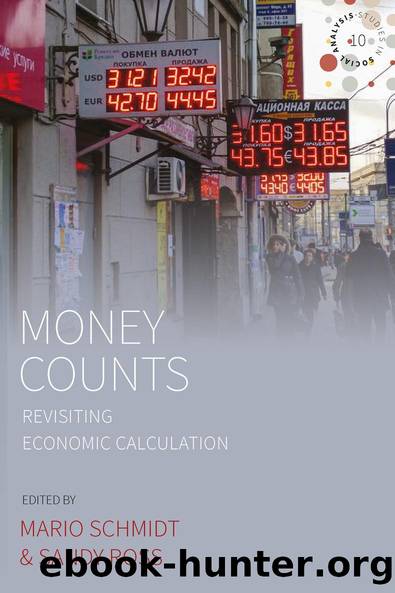Money Counts by Mario Schmidt Sandy Ross

Author:Mario Schmidt, Sandy Ross [Mario Schmidt, Sandy Ross]
Language: eng
Format: epub
ISBN: 9781789206845
Barnesnoble:
Publisher: Berghahn Books, Incorporated
Published: 2020-01-16T00:00:00+00:00
Investing Capital: Combinatory Numerical Practices against Uncertainty
Discussing financial issues with poor jo-Kaleko usually elicits invocations and fantasies about what they would do if they had what they call âcapitalâ. For them, the English term âcapitalâ indicates a precise sum needed for an intended project, such as building an orphanage or a house or producing music videos. As a consequence of widespread interest in capital, the sidewalks of Western Kenyaâs biggest city, Kisumu, are littered with self-help books (Cash Clinic, Who Wants to Be the Next Millionaire, Smart Money for Smart Students), and money-making schemes are abundantly available in Western Kenya. Many jo-Kaleko participate in several rural rotating savings and credit associations (kosalo), using each one for different purposes: security, savings, or obligation (see Shipton 2010). Almost everybody wants to become a rich person, one âwho invests a lot.â
Jack Okech, a 24-year-old law student at the University of Nairobi and a classmate of Tom, is no exception. When I suggested that his rural projectâa chicken farm to be built in Kalekoâmight fail because of unforeseen difficulties, he responded energetically: âOne chicken is 50 bob [KSh], when I buy 400, 20,000 ⦠400, letâs say 40 die, that is 360, each lays an egg a day. If 1 egg is 9 bob wholesale price, per month that is 30 times 9 times 360 ⦠let me check with my mobile, 97,600. And when they are older, I sell them for 350 shillings each, that is 126,000 ⦠Some of the money I will lose on chicken feed ⦠but all in all, why should anyone invest in losses?â The chain of monetary amounts that Jack constructs is comparable to the ground-figure reversals at work with pesa nono. He imagines the initial investment of 20,000 KShâsplit into 400 x 50 KShâwill become revenue of 97,600 KSh. Once money for chicken feed (f) is subtracted (97,600 KSh â f), the remainder could be reinvested or saved until Jack can add 126,000 KSh to his wealth (w). Continuous investing resembles working toward amounts of the same sizeâone whole that can be investedâand of a different sizeâinitially 20,000 KSh, then 97,600 KSh â f, then w + 126,000 KSh. All three sums function as the same ground (one whole) from which further amounts of capital proceed as figures. Unlike the internalized ground-figure loop of pesa nono, capital investment is a successfully externalized ground-figure loop.
However, what made Jack so optimistic, especially since most comparable projects fail? While discussing investments with him and other jo-Kaleko, I always felt that sitting down, using a calculator, and playing around with, and referring to, concrete numbers provided them with a feeling of control. Sketching out numerical relations between amounts of money (20,000 KSh), goods (360 chickens), and temporal information (an egg a day), gave Jack control over capitalâs future application by portraying the investment development as a unique whole composed solely of numerical parameters:
[(50 x 400) + (400â40) x 30 x 9 x 1 + 350 x 360]
The money Jack hoped to possess in the future does not make diverse goods commensurable.
Download
This site does not store any files on its server. We only index and link to content provided by other sites. Please contact the content providers to delete copyright contents if any and email us, we'll remove relevant links or contents immediately.
International Integration of the Brazilian Economy by Elias C. Grivoyannis(98633)
The Radium Girls by Kate Moore(11970)
Turbulence by E. J. Noyes(7977)
Nudge - Improving Decisions about Health, Wealth, and Happiness by Thaler Sunstein(7655)
The Black Swan by Nassim Nicholas Taleb(7054)
Rich Dad Poor Dad by Robert T. Kiyosaki(6507)
Pioneering Portfolio Management by David F. Swensen(6253)
Man-made Catastrophes and Risk Information Concealment by Dmitry Chernov & Didier Sornette(5951)
Zero to One by Peter Thiel(5730)
Secrecy World by Jake Bernstein(4698)
Millionaire: The Philanderer, Gambler, and Duelist Who Invented Modern Finance by Janet Gleeson(4417)
The Age of Surveillance Capitalism by Shoshana Zuboff(4243)
Skin in the Game by Nassim Nicholas Taleb(4200)
Bullshit Jobs by David Graeber(4137)
The Money Culture by Michael Lewis(4130)
Skin in the Game: Hidden Asymmetries in Daily Life by Nassim Nicholas Taleb(3960)
The Dhandho Investor by Mohnish Pabrai(3721)
The Wisdom of Finance by Mihir Desai(3693)
Blockchain Basics by Daniel Drescher(3538)
